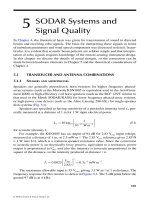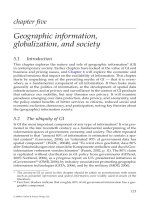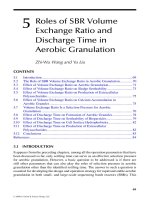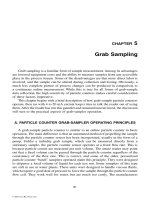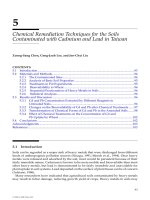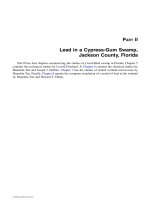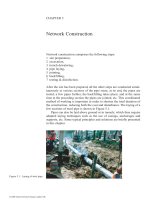Sulfate Attack on Concrete - Chapter 5 pot
Bạn đang xem bản rút gọn của tài liệu. Xem và tải ngay bản đầy đủ của tài liệu tại đây (435.02 KB, 19 trang )
5Consequences of sulfate
attack on concrete
5.1INTRODUCTION
As discussed in the previous chapter, concrete subject to sulfate attack
undergoes a progressive and profound reorganization of its internal micro-
structure. These alterations have direct consequences on the engineering
properties of the material. As will be seen in the following paragraphs,
concrete undergoing sulfate attack is often found to suffer from swelling,
spalling and cracking. There is overwhelming evidence to show that the
degradation also contribute to significantly reduce the mechanical proper-
ties of concrete. Many structures affected by sulfate degradation often need
to be repaired or, in the most severe cases, partially reconstructed.
The various consequences of sulfate attack on concrete are reviewed in
the following sections. Throughout the text, distinction is made between
concrete suffering from internal sulfate degradation and that affected by
external sulfate attack. The behavior of hydrated cement systems tested
under well-controlled laboratory conditions is also distinguished from the
performance of concrete in service.
5.2EXTERNAL APPEARANCE AND VOLUME STABILITY
OF CONCRETE ATTACKED BY SULFATE
As emphasized in Chapter 4, it is now well established that hydrated cement
systems subject to sulfate attack often sustain damage as a result of excessive
volume change. For instance, the swelling behavior of concrete suffering from
“internal” sulfate attack has been the subject of numerous reports (Day
1992; Diamond 1996; Lawrence 1995a,b). The volume instability of mortar
and concrete mixtures exposed sulfate solutions is also well documented
(Gollop and Taylor 1992–1996, Mehta 1992; Odler and Jawed 1991; Thor-
valdson 1952). For additional information see Thorvaldson et al. (1925, 1927,
1928) and Tuthill (1936).
© 2002 Jan Skalny, Jacques Marchand and Ivan Odler
The macroscopic manifestations of both types of degradation will be
reviewed in separate sections. The volume instability of concrete subjected
to internal sulfate attack will be briefly reviewed in Section 5.2.1. The topic
has already been discussed in the previous chapter (see Section 4.8.2). A
more comprehensive discussion of the macroscopic behavior of concrete
suffering from external sulfate attack is presented in Section 5.2.2.
5.2.1External appearance and volume stability of concrete
subjected to internal sulfate attack
Deleterious expansion may occur in concrete when excessive amounts of
gypsum or anhydrite, in quantities well above normal levels, are present in
the cement. Excess sulfate in concrete can also originate from contaminated
aggregates (Figg 1999; St John et al. 1958). As emphasized by Harboe
(1982), admissible limits for the aggregate sulfate content may vary from one
source to another, and laboratory trial tests are recommended to evaluate
the performance of potentially reactive aggregates.
Typical dilation curves for laboratory samples subjected to internal sul-
fate attack are shown in Figure 5.1 (Ouyang et al. 1988). These results were
obtained by testing a series of mortar prisms according to the prescriptions
of ASTM C452. It should be emphasized that, in this case, expansion arised
from excess gypsum initially added to the various mixtures during their
production. In that respect, the curves appearing in Figure 5.1 are examples
of what has been referred to as composition-induced internal sulfate attack in
Section 4.8.2.
As can be seen in Figure 5.1, expansion develops very quickly. Furthermore,
the rate of expansion becomes linear after only a few days of test. Ouyang
et al. (1988) reported that significant cracking and strength loss could be
observed when the samples had experienced approximately 0.3% expansion.
This aspect of the problem will be further discussed in Section 5.4.
ASTM C1038 allows the quantity of SO
3
in the cement and pozzolan, and
thus in concrete, to increase beyond the chemical requirements by any
amounts, as long as expansion after fourteen days of immersion in water is
less than 0.02%. Recently, Day (2000) found a positive correlation between
the fourteen-day dilation measured according to ASTM C1038 and the long-
term expansion of mortar.
In the literature, various other expansion limits have been proposed for
concrete samples subjected to composition-induced internal sulfate attack.
For instance, Samarai (1976) recommended 0.1% expansion as a safe margin
for determining the maximum percentage of sulfate that can be added to
a given mixture without causing any significant degradation. Crammond
(1984) used 0.1% expansion after six months as the limit above which swell-
ing becomes significantly deleterious. As pointed out by Ouyang et al.
(1988), this limit is also suggested by ASTM C227 as an acceptance criterion
for alkali-aggregate reactivity.
© 2002 Jan Skalny, Jacques Marchand and Ivan Odler
According to St John et al. (1958), field observations of composition-induced
internal sulfate attack indicate that degradation can be, in many cases, spectacu-
lar. Expansion usually occurs within weeks or months due the relatively high
reactivity of gypsum. Efflorescence, scaling, spalling and cracking are wide-
spread, and require the removal of the contaminated concrete.
A typical dilation curve for a mortar sample subjected to heat-induced
internal sulfate attack (or DEF) is presented in Figure 5.2. As can be seen,
the kinetics of expansion can be much different from what is usually seen for
composition-induced internal sulfate attack (see Figure 5.1). The expansion
of heat-cured samples tends to begin after an initial “incubation” period
during which very little swelling if any, is observed. In addition, expansion
curves are usually non-linear. As can be seen in Figure 5.2, the dilation curves
are rather characterized by their S-shape.
It should also be kept in mind that a wide range of parameters might influ-
ence the kinetics of dilation of samples affected by heat-induced sulfate attack.
For instance, a critical review by Day (1992) of a series of studies specifically
devoted to DEF indicates that the intensity and the onset of swelling tend
tovary according to the size and the shape of the samples. Laboratory experi-
ments also demonstrate the volume instability is also affected by post-heat
treatment storage conditions such as temperature, moisture content and the
concentration of alkali ions in the surrounding solution (Day 1992; Famy 1999).
F
igure 5.1Expansion of mortars containing different types of cement under internal
sulfate attack.
Source:Ouyang et al. (1988)
© 2002 Jan Skalny, Jacques Marchand and Ivan Odler
As extensively discussed in Section 4.8.2, available information shows that
heat-induced sulfate attack (or DEF) of field concrete is characterized by
map cracking, longitudinal cracking and occasional warping of the element.
Over the past decades, the behavior of steam-cured railroads ties suffering
from DEF has received a lot of attention. In most of the documented cases,
visible damage was reported several years after the products have been man-
ufactured and in use. Damage was characterized by development of cracks
that started at the corners and edges of the concrete element and gradually
spread into deeper regions as the time progressed. Elements not directly
exposed to moisture were usually found to be less damaged or undamaged.
Typical field cases are presented in Chapter 8.
5.2.2External appearance and volume stability of concrete
subjected to external sulfate attack
Most of the information available on the volume instability of concrete exposed
to sulfate solutions originates from laboratory experiments performed under
well-controlled conditions. In a typical experiment (such as ASTM C1012),
relatively small samples are kept continuously immersed in the test solution.
Specimens are visually inspected at regular intervals. Changes in mass
and length are also regularly monitored. A critical appraisal on the various
standard test methods specifically designed to assess the durability of hydrated
cement systems to sulfates is given in Chapter 9.
Typical length-change curves, obtained by Brown (1981), are given in Figure
5.3. As can be seen, the immersion of the samples in the test solutions is first
followed by an “incubation” period (similar to the one seen for samples
F
igure 5.2Mortar prism expansions after extended heat cure periods at 95–100
°
C.
Source: Lawrence (1995b)
© 2002 Jan Skalny, Jacques Marchand and Ivan Odler
affected by heat-induced internal sulfate degradation) during which the
specimens do not experience any significant swelling. However, after a few
days of immersion, the length-change curve is definitively inflected upwards
and finally the rate of expansion becomes almost constant until total dis-
integration of the samples.
Over the years, numerous expansion limits have been suggested as failure
criterion for mortar and concrete samples exposed to sulfate attack. For
instance, Smith (1958) defined failure as 0.5% expansion, which was found to
correspond to approximately 40% loss in the dynamic modulus of elasticity. In
his comprehensive review of the resistance of concrete to external sulfate
attack, Tuthill (1978) used 0.4% expansion as an indication of the complete
failure of test samples. More recently, Mather (1982) proposed an expansion
limit of 0.1% as a criterion for failure of hydrated cement systems in contact
with sulfate solutions. Patzias (1987) also suggested that 0.1% expansion at
180 days would be appropriate as a maximum acceptance limit for moderate
sulfate resistance, and 0.05% expansion at 180 days as a limit for high sulfate
resistance when the expansion test is performed according to ASTM C1012.
The relevance of these various criteria with respect to the evolution of the
mechanical properties of concrete will be further discussed in Section 5.4.
The expansion of concrete is usually accompanied by the development of
cracks into the material. Numerous studies indicate that cracking is usually
F
igure 5.3 Relationship between the mortar bar expansion and the sulfate ion con-
sumption per unit surface area of sample at pH 6, 10 and 11.5.
Source: Brown (1981)
© 2002 Jan Skalny, Jacques Marchand and Ivan Odler
initiated near the surface and gradually evolves towards the central portion
of the sample (Gollop and Taylor 1992–1996; Lagerblad 1999). According
to Lagerblad (1999), cracks can be detected by a visual inspection when the
linear expansion of the sample exceeds 0.7%. At later stages of degradation,
severe cracking often is accompanied by delamination and exfoliation, and
may eventually lead to the total disintegration of the sample (Thorvaldson
etal. 1927).
Over the years, various authors have relied on visual inspections to evaluate
the resistance of laboratory samples to sulfate attack. For instance, Lerch
(1961) and Stark (1989) used this approach to study the performance of test
beams exposed to sulfate-rich soils. Their assessment was based on a numer-
ical rating system ranging from 1.0 (indicating no evidence of degradation)
to 6.0 (indicating failure).
However, it should be emphasized that the sole visual inspection of labor-
atory samples can be misleading. For instance, during an investigation of
the influence of fly ash on the sulfate resistance of mortars, Day and Ward
(1988) could observe expansions of 1% and more (accompanied by signific-
ant reductions of the mechanical properties of the samples) without any
obvious signs of degradation. These results clearly emphasize the need for
more rigorous methods to evaluate the performance of hydrated cement
systems subjected to sulfate attack.
Numerous investigations have also clearly indicated that the volume instabil-
ity of concrete under sulfate attack is influenced by a wide range of para-
meters. As can be seen in Figure 5.3, the kinetics of expansion is particularly
sensitive to the pH of the test solution (Brown 1981). The detrimental effect
of low pH has also been confirmed by Ferraris et al. (1997). The importance
of pH will be discussed in further detail in Chapter 9.
Test results also indicate that the nature and the concentration of the sulfate
solution also affect swelling. For instance, magnesium sulfate solutions are
usually found to be more aggressive than sodium sulfate solutions (Gollop
and Taylor 1992–1996; Thorvaldson et al. 1927). However, these observations
should be considered with caution. As pointed out by Verbeck (1968) and
Day (2000), the use of magnesium sulfate solution in a static soaking test
(i.e. without any stirring of the solution) can result in the formation of a pro-
tective magnesium hydroxide coating on the surface of the test samples. As a
result, ions from the attacking solution cannot penetrate into the material.
The result is lower expansion than would have been observed in the absence
of this protective layer.
A similar phenomenon has been reported for dense concrete fully sub-
merged in sea water (Buenfeld and Newman 1986; Mehta 1991; Taylor
1997). The combined action of magnesium (Mg
2
+
) and carbonate (HCO
−
3
)
often result in the formation of a surface skin, typically consisting of a thin
layer of brucite overlaid by a more slowly developing layer of aragonite. The
presence of this surface skin has been found to protect initially dense concrete
from further degradation.
© 2002 Jan Skalny, Jacques Marchand and Ivan Odler
It should however be emphasized that authors who have investigated the
behavior of concrete exposed to sea water have not consistently reported the
formation of this protective layer. For instance, Thomas et al. (1999) recently
investigated the behavior of a series of laboratory concrete mixtures
prepared at water–binder ratios ranging from 0.32 to 0.68. Some of these
mixtures contained various amounts of fly ash. After twenty-eight days of
curing, samples were placed in the tidal zone of the BRE marine exposure
site on the Thames Estuary. After ten years of exposure, no evidence of a
brucite layer on the surface of concrete could be detected. Examination by
SEM showed that the surface layers were characterized by a decalcifica-
tion of C-S-H with aragonite, magnesium silicate, and thaumasite being the
primary reaction products.
Given the importance of the problem, the performance of field concrete
exposed to sulfate-laden environments is well documented. Early reports
date back to the beginning of the previous century (DePuy 1997; Lafuma
1927; Wig and Willams 1915; Wig et al. 1917). Since then, numerous com-
prehensive descriptions of the premature degradations of concrete structures
exposed to sulfate solutions and sulfate-contaminated soils have been
published.
As emphasized by Hamilton and Handegord (1968), the degradation of
field concrete by sulfate attack does not usually result in the sudden failure
of the structure. The detrimental action of sulfates is a progressive process
of deterioration that often leads to collapse or to the necessity of demolition.
Field reports indicate that the rate of deterioration can be particularly rapid
and severe when concrete exposed to sulfates is continuously kept in satu-
rated (or nearly saturated) conditions (Tuthill 1978).
One typical manifestation of the degradation of field concrete subjected
to external sulfate attack is the expansion of structural elements and the
subsequent development of cracks. Numerous reports of concrete slabs,
placed directly on moist soils contaminated with sulfates (often called alkali
soils), that have failed in buckling can be found in the literature (Figg 1999;
Hamilton and Handegord 1968; Novak and Colville 1989; Price and Peterson
1968; Tuthill 1978). Although the onset of cracking in some cases is associated
with soil expansion, the volume instability often appears to be the primary
cause of distress.
The development of sulfate-induced cracking is not limited to slabs on
grade. Sulfate attack has been clearly identified as the primary cause for the
progressive degradation of mass concrete structures (Harboe 1982; Price
and Peterson 1968; Reading 1982). One typical case involves the premature
failure of concrete in the gate structure of a large submerged shipway in
south-eastern United States (Terzaghi 1948). Various defects could be
observed only two years after construction. The development of cracks at the
pier surface was attributed to the abnormal expansion of concrete. The volume
instability of concrete was ascribed to deleterious chemical reactions with
sulfate ions originating from sea water.
© 2002 Jan Skalny, Jacques Marchand and Ivan Odler
As mentioned by St John et al. (1958), cracking is not the sole consequence
of sulfate attack. Exfoliation and spalling are other frequent manifestations
of the problem. These forms of degradation are often reported for slabs and
foundations directly in contact with sulfate-contaminated soils (Haynes
2000; Haynes et al. 1996; Mehta 2000; Novak and Colville 1989; Tuthill
1978). The presence of efflorescing materials (typically sodium sulfate under
the form of thenardite and mirabilite) is often reported as a precursor to this
type of damage.
As discussed in Chapter 4, this type of degradation is often attributed to
the crystallization of sulfate salts at the surface of concrete. According to
Haynes et al. (1996), the mechanisms of degradation involve the penetra-
tion of sulfate solutions either by simple diffusion or by capillary suction
when pore water evaporates from above-ground surfaces, the sulfate con-
centration becomes sufficiently high to cause crystallization. Changes in
ambient temperature and relative humidity cause some salts to undergo
cycles of dissolution and crystallization, which may be accompanied by
volume expansion.
For some authors, this form of degradation should be distinguished from
classical sulfate attack and referred to as “physical” sulfate deterioration
(Haynes 2000; Haynes et al. 1996; Hime and Mather 1999). The relevance of
this distinction has been addressed in Chapter 4 and will be further discussed
in Chapter 8.
It should finally be emphasized that visual inspections of field concrete
structures can be misleading, and should be considered with caution. Over
the past decades, numerous authors have reported cases of badly degraded
concrete (with little or any residual strength) that displayed no apparent
signs of alteration (Hamilton and Handegord 1968; Harboe 1982; Price
and Peterson 1968; Reading 1982). Further investigations of these struc-
tures showed that concrete had little residual mechanical strength, if
any.These examples clearly emphasize the inherent limitations of visual
inspections.
5.3CONSEQUENCES OF SULFATE ATTACK ON THE
MICROSTRUCTURE OF CONCRETE
In Chapter 4, the consequences of sulfate attack (from internal or external
causes) on the microstructure of concrete have been extensively discussed.
As emphasized in Chapter 4, the various types of sulfate degradation are
often found to result in similar forms of distress, such as the development of
gaps around some aggregate particles and the onset of microcracking.
However, systematic microscopic observations of concrete samples suffering
from composition-induced sulfate attack, DEF and external sulfate degrada-
tion indicate that the evolution of the microstructural damage may vary from
one type of degradation to another.
© 2002 Jan Skalny, Jacques Marchand and Ivan Odler
Reports on the degradation of concrete by composition-induced and
heat-induced (DEF) internal sulfate attack tend to indicate that degradation
is usually rather homogeneous throughout the entire volume of concrete
(Johansen et al. 1993; Johansen et al. 1995; St John et al. 1958). This is, for
instance, the case for laboratory samples exposed to well-controlled condi-
tions. As previously mentioned, cracking of field concrete structures affected
by DEF has been reported to evolve from the external surfaces to the core of
the element. However, systematic observations of degraded samples usually
indicate the formation of deleterious ettringite throughout the entire volume
of concrete. In addition, cracks often tend to propagate relatively quickly
from the external surfaces through the core of the element.
On the contrary, most of the investigations published on the subject indicate
that external sulfate attack usually proceeds by the inward movement of
degradation “fronts” (Taylor 1997). For instance, using X-ray microanalyses,
backscattered electron imaging and scanning electron microscopy, Gollop and
Taylor (1992) found that laboratory samples immersed in sodium sulfate and
magnesium sulfate solutions were characterized by a succession of layers (or
zones) starting from the outer surface of the specimens. Each zone was found
to be the result of a series of reactions between the external sulfate ions and
the aluminate and calcium-bearing phases initially present within the material.
The presence of layers in laboratory samples tested for external sulfate
attack was more recently confirmed by Wang (1994) who reported distribu-
tion curves for ettringite, gypsum, and portlandite in cement paste prisms
(w/c
=
0.4–0.6) immersed in a sodium sulfate solution (at 350mmol/l and
pH
=
6) for fourteen days. These curves were obtained by layer-by-layer XRD
analyses. Prior to the immersion in the solution, the samples were coated on
all faces except two. During the immersion, one of the uncoated faces was
exposed to a sulfate solution and the other was exposed to air. Test results
clearly demonstrate that the material was damaged by the exposure to the
sodium sulfate solution. As for the samples tested by Gollop and Taylor
(1994), damage induced by sulfate attack was characterized as a transitional
change in the phase distribution at the vicinity of the surface exposed to the
sulfate solution (see Figure 5.4).
It should be emphasized that the formation of layers upon sulfate attack is
not solely limited to laboratory specimens. Systematic observations per-
formed by various authors also indicate the presence of reaction zones in
field concrete samples. For instance, examination by St John (1982) of thin
sections of concrete taken from tunnel sections exposed to ground water
contaminated with sodium sulfate (and containing less than 50 ppm of SO
4
)
revealed the presence of exfoliated layer near the surface. The altered layer
was characterized by the presence of cracks filled with gypsum, which graded
abruptly into apparently sound concrete.
More recently, Diamond and Lee (1999), Ju et al. (1999), Brown and Doerr
(2000) and Brown and Badger (2000) made similar observations for samples
of permeable concrete originating from flatworks which had been exposed
© 2002 Jan Skalny, Jacques Marchand and Ivan Odler
for many years to sulfate-bearing soils. Extensive examinations of these samples
using backscatter mode SEM and Energy-Dispersive X-Ray Analyses (EDXA)
revealed the presence of deposits of crystalline sulfates on the upper surfaces
of the slabs. Zones of degradation and reaction fronts could also be discerned
in the bottom portion of the slabs in contact with the soil. In many cases, the
analyses revealed the presence of gypsum at the vicinity of the lower surface of
the cores. A second zone with extensive ettringite formation was routinely found
to lie above the layer of gypsum. Although the precipitation of sulfate-bearing
phases in these porous systems had apparently not resulted in significant mac-
roscopic expansion, it had clearly contributed to the formation of microcracks.
As will be seen in the following section, the formation of these layers readily
complicates the study of the detrimental influence sulfate attack on the
engineering properties of concrete. Given the heterogeneous nature of the
degradation process, it is usually difficult to isolate the effect of a single
phenomenon (such as ettringite formation).
5.4CONSEQUENCES OF SULFATE ATTACK ON THE
MECHANICAL PROPERTIES OF CONCRETE
Reports on the consequences of composition-induced internal sulfate attack
clearly indicate that this form of degradation not only results in the forma-
tion of a network of microscopic and macroscopic cracks but also contributes
to significantly reduce the mechanical properties of concrete.
The effect of composition-induced sulfate attack on the volume stability
and compressive strength of a series of mortars is presented in Figure 5.5.
These results reported by Ouyang et al. (1988) were obtained for mixtures to
which excess gypsum (added under the form of phosphogypsum) was added.
0
20
40
60
80
100
0100200300400500600700800
Relativepeakintensity
Distance (microns)
Portlandite
Gypsum
(B)
0
5
10
15
20
25
30
35
40
0100200300400500600700800
Relativepeakintensity
Distance (microns)
Portlandite
Ettringite
(A)
F
igure 5.4Phase distributions for moderate sulfate resistant cement, w/c
=
0.6, cured
for seven days, and immersed at pH
=
6 for fourteen days.
Source: Wang (1994)
© 2002 Jan Skalny, Jacques Marchand and Ivan Odler
As can be seen, the three compressive strength curves show exactly the same
behavior. Despite the fact that all mixtures were found to expand right from
the beginning of the tests, the compressive strength of all samples initially
increased. This initial gain is probably due to continuous hydration and
eventually to the pore filling effect of ettringite and gypsum formation. After
a few months of curing, compressive strength values were found to peak and
then decrease. Significant reductions were observed for the mixtures prepared
at a cement content of 20% and 15% respectively.
The authors found that that the cement content of the mixture influenced
the admissible expansion beyond which the compressive strength of mortar
was detrimentally affected. They proposed the following relationship to predict
the value of this critical expansion (noted E and expressed in mm/mm):
E
=
0.0026
+
0.01C (5.1)
where C is the cement content (expressed as a percentage of the total mass
of the mixture).
The results reported by Ouyang et al. (1988) are in good agreement with
observations of field concrete affected by composition-induced internal sulfate
attack (Harboe 1982; St John et al. 1958). As previously mentioned, degradation
is usually found to result in severe cracking and significant strength reduction.
F
igure 5.5 Effect of cement content on strength and expansion of mortars under
internal sulfate attack (1.0 ksi
×
6.89 MPa).
Source:Ouyang et al. (1988)
© 2002 Jan Skalny, Jacques Marchand and Ivan Odler
Studies on the consequences of DEF also indicate that this form of
internal sulfate attack can also have detrimental effects on the compressive
strength of concrete. Data reported by Lewis et al. (1995) indicate that heat-
cured mortars affected by DEF tend to behave similarly to samples suffer-
ing from composition-induced sulfate attack. After an initial increase, the
compressive strength of most mortar samples was found to decrease signifi-
cantly. The time at which the strength started to decrease was believed to
correspond well with the onset of expansion. However, no systematic rela-
tionship between expansion and compressive strength could be observed.
Over the past decade, numerous authors have investigated the influence
of external sulfate attack on the mechanical properties of concrete. Most
studies published on the subject tend to indicate that the reorganization of
the internal microstructure of concrete is accompanied by a significant
reduction of the material’s strength and rigidity (elastic modulus).
As previously mentioned, the layered damage resulting from external
sulfate attack has often complicated the work of researchers. In order to
work on a relatively homogeneous material (for which degradation was more
or less uniform throughout its volume), many authors have elected to test
relatively small samples. The reduced dimensions of the samples also explain
why many studies were conducted on mortar samples. In that respect, one
should be cautious in interpreting and comparing such tests vis-à-vis samples
of concrete of larger dimensions.
Typical laboratory results on the effect of sulfate attack on the compressive
and tensile strengths of mortar mixtures are given in Figures 5.6 and 5.7. As
can be seen, the immersion in a sulfate solution initially results in a slight
increase in strength (Brown 1981; Jambor 1998; Thomas et al. 1999; Thorval-
dson et al. 1927). A similar trend was also reported for the stress corrosion of
well-cured paste mixtures subjected to flexural loading while immersed in a
Na
2
SO
4
solution (Werner et al. 2000). After this initial gain, the material
usually loses strength very rapidly.
As discussed in Chapter 4, the initial gain in strength might be associ-
ated to hydration effects and to the precipitation of ettringite, which tends
to reduce the porosity of the material. The subsequent loss in strength and
rigidity of the material is often attributed to expansion and the onset of
microcracking. This analysis is in good agreement with the data of Ouyang
et al. (1988) and those of Ouyang (1989) which show that the beginning of
the strength loss usually corresponds to an expansion of 0.1% (see Figure
5.8).
Results on the initial strength gains of laboratory samples subjected to
external sulfate attack should be considered with caution. As can be seen in
Figure 5.6, no such increase can be observed for samples immersed in low pH
solutions. This phenomenon can probably be explained by the fact that low pH
solutions favor the formation of ettringite and the dissolution of calcium
hydroxide crystals (Marchand et al. 1999a). Over the past decades, numerous
studies have clearly emphasized the detrimental influence of portlandite
© 2002 Jan Skalny, Jacques Marchand and Ivan Odler
F
igure 5.6 Variation in cube strength with time under the following experimental
conditions: distilled water immersion, immersion in 0.35 M Na
2
SO
4
with-
out pH control, and immersion in 0.35 M Na
2
SO
4
while maintaining the
solution pH at 6, 10 and 11.5.
Source: Brown (1981)
F
igure 5.7 Comparison of expansion of mortar bars and tensile strength of bricquets
in 0.15 M solution of Na
2
SO
4
at 22
°
C.
Source: Thorvaldson et al. (1927)
© 2002 Jan Skalny, Jacques Marchand and Ivan Odler
dissolution on the mechanical properties of hydrated cement systems (March-
and et al. 1999b; Terzaghi 1948; Tremper 1931; Saito and Deguchi 2000).
The reorganization of the internal microstructure of concrete subjected to
sulfate attack also tends to increase the susceptibility of the material to stress
corrosion. Typical results obtained by Schneider and Piasta (1991) are given
in Figure 5.9. As can be seen, the combined action of sustained flexural load
F
igure 5.8 Effect of cement content on strength and expansion of mortars under
external sulfate attack (1.0 ksi
=
6.89 MPa).
Source:Ouyang et al. (1988)
F
igure 5.9 Change in the elastic modulus of concrete under load immersed in various
solutions.
Source: Schneider and Piasta (1991)
© 2002 Jan Skalny, Jacques Marchand and Ivan Odler
and chemical attack by a Na
2
SO
4
solution clearly contributes to accelerate
the reduction in the elastic modulus of the material.
Reports on the behavior of field concrete tend to confirm the detrimental
effect of external sulfate attack on the mechanical properties of the material.
For instance, many authors reported marked losses in compressive strength
for concrete structures exposed to sulfate-laden soils or sea water (Hamilton
and Handegord 1968; Harboe 1982; Price and Peterson 1968; Terzaghi
1948).
Curiously, it appears that the shear resistance and tensile strength of con-
crete are more sensitive to external sulfate attack than compressive strength
(Hamilton and Handegord 1968; Harboe 1982). This phenomenon can
probably be explained (at least in part) by the layered damage resulting from
external sulfate attack. The tensile strength and the shear resistance of con-
crete are more sensitive by internal defects than compressive strength.
5.5 CONCLUDING REMARKS
As can be seen, whatever its form, sulfate attack has significant consequences
on the microstructure and engineering properties of concrete. Marked expan-
sion and loss in the mechanical properties of the material often accompany
sulfate-induced microstructural alterations. However, as emphasized by Skalny
and Pierce (1999), damage induced by sulfate can be easily avoided (or at
least limited) by simple measures. This point will be briefly reviewed in the
following chapter.
REFERENCES
Brown, P.W. (1981) “An evaluation of the sulfate resistance of cements in a controlled
environment”, Cement and Concrete Research
11
: 719–727.
Brown, P.W. and Badger, S. (2000) “The distributions of bound sulfates and chlorides in
concrete subjected to mixed NaCl, MgSO
4
, Na
2
SO
4
attack”, Cement and Concrete
Research
30
: 1535–1542.
Brown, P.W. and Doerr, A. (2000) “Chemical changes in concrete due to ingress of
chemical species”, Cement and Concrete Research
30
: 411–418.
Buenfeld, N.R. and Newman, J.B. (1986) “The resistivity of mortars immersed in sea
water”, Cement and Concrete Research
16
: 511–524.
Crammond, N.J. (1984) “Examination of mortar bars containing varying percentages of
coarsely crystalline gypsum as aggregate”, Cement and Concrete Research
14
: 225–230.
Day, R.L. (1992) “The effect of secondary ettringite formation on the durability of
concrete: a literature analysis”, PCA R&D Bulletin RD108T.
Day, R.L. (2000) “Development of performance tests for sulfate attack on cementitious
systems”, Cement Concrete and Aggregates
22
: 169–178.
Day, R.L. and Ward, M.A. (1988) “Sulphate durability of plain and fly ash mortars”,
MRS Symposia Proceedings,
113
: 153–161.
© 2002 Jan Skalny, Jacques Marchand and Ivan Odler
DePuy, G.W. (1994) “Chemical resistance of concrete”, in Lamond and Klieger (eds)
Tests and Properties of Concrete, STP 169C, ASTM, Philadelphia, 263.
DePuy, G.W. (1997) “Review of sulfate attack in US and Canada”, report submitted
on behalf of plaintiffs in Murphy v. First Southwest Diversified Partners, Case
#752593 (Orange County Superior Court, California, 1997), November 3, 89 pp.
Diamond, S. (1996) “Delayed ettringite formation – processes and problems”, Cement
and Concrete Composites
18
: 205–215.
Diamond, S. and Lee, R.J. (1999) “Microstructural alterations associated with sulfate
attack in permeable concretes”, in J. Marchand and J. Skalny (eds) Materials
Science of Concrete Special Volume: Sulfate Attack Mechanisms, The American
Ceramic Society, Westerville, OH, pp. 123–173.
Famy, C. (1999) “Expansion of heat-cured mortars”, Ph.D thesis, University of
London, September.
Ferraris, C.F., Clifton, J.R., Stutzman, P.E. and Gaboczi, E.J. (1997) “Mechanism of
degradation of Portland cement-based systems by sulfate attack” in K. Scrivener
and J.F. Young (eds) Mechanism of Chemical Degradation of Cement-based Systems,
E & FN Spon, pp. 185–172.
Figg, J. (1999) “Field studies of sulfate attack on concrete”, in J. Marchand and
J. Skalny (eds) Materials Science of Concrete Special Volume: Sulfate Attack
Mechanisms, The American Ceramic Society, Westerville, OH, pp. 315–324.
Gollop, R.S. and Taylor, H.F.W. (1992–1996) “Microstructural and microanalytical
studies of sulfate attack I. Ordinary cement paste. II. Sulfate resisting Portland
cement: ferrite composition and hydration chemistry. III. Sulfate-resisting Portland
cement: reactions with sodium and magnesium sulfate solutions. IV. Reactions of
a slag cement paste with sodium and magnesium sulfate solutions. V. comparison
of different slag blends”, Cement and Concrete Research 22: 1027–1038; 24: 1347–
1358; 25: 1581–1590; 26: 1013–1028; 26: 1029–1044.
Hamilton, J.J. and Handegord, G.O. (1968) “The performance of ordinary Portland
cement concrete in prairies soils of high sulphate content”, in E.G. Swenson (ed.)
Performance of Concrete-Resistance of Concrete to Sulphate and Other Environmental
Conditions: A Symposium in Honour of Thobergur Thorvaldson, University of Toronto
Press, pp. 135–158.
Harboe, E.M. (1982) “Longtime studies and field experiences with sulfate attack”, in
Sulfate Resistance of Concrete (George Verbeck Symposium), ACI SP-77, pp. 1–20.
Haynes, H. (2000) “Sulfate attack on concrete: laboratory versus field experience”, Suppl.
Proc. 5th CANMET/ACI Int.Conf. Durability of Concrete, Barcelona, June (in press).
Haynes, H., O’Neill, R. and Mehta, P.K. (1996) “Concrete deterioration from physical
attack by salts”, Concrete International 18(1) (January): 63–68.
Hime, W.G. and Mather, B. (1999) “‘Sulfate Attack’ or is it?”, Cement and Concrete
Research,
29
: 789–791.
Jambor, J. (1998) “Sulfate corrosion of concrete”, unpublished manuscript summarizing
Dr Jambor’s work on the Sulfate durability of concrete. (The author passed away in
May 1998.)
Johansen, V., Thaulow, N. and Skalny, J. (1993) “Simultaneous presence of alkali-
silica gel and ettringite in concrete”, Adv. Cem. Res.
5
: 23–29.
Johansen, V., Thaulow, N. and Skalny, J. (1995) “Internal reactions causing cracking
of concrete”, Beton
+
Fertigteil Technik
11
: 56–68.
Ju, J.W., Weng, L.S., Mindess, S. and Boyd, A.J. (1999) “Damage assessment and
service-life prediction of concrete subject to sulfate attack”, in J. Marchand and
© 2002 Jan Skalny, Jacques Marchand and Ivan Odler
J. Skalny (eds) Materials Science of Concrete Special Volume: Sulfate Attack Mecha-
nisms, The American Ceramic Society, Westerville, OH, pp. 265–282.
Lafuma H. (1927) “Theory of expansion of cement” (in French), Revue des Materiaux
de Construction et de Traveaux Public
243
: 441–444.
Lagerblad, B. (1999) “Long-term test of concrete resistance against sulfate attack”, in
J. Marchand and J. Skalny (eds) Materials Science of Concrete Special Volume: Sulfate
Attack Mechanisms, The American Ceramic Society, Westerville, OH, pp. 325–336.
Lawrence C.D. (1995a) “Delayed ettringite formation: an issue?”, in J. Skalny and
S. Mindess (eds) Material Science of Concrete, vol. IV, The American Ceramic
Society, Westerville, OH, 113 pp.
Lawrence, C.D. (1995b) “Mortar expansions due to delayed ettringite formation”,
Cem. Concr. Res.
25
: 903–914.
Lerch, W. (1961) “Significance of tests for sulfate resistance”, Proceedings, ASTM
STP
61
: 1043–1054.
Lewis, M.C., Scrivener, K.L. and Kelham, S. (1995) “Heat curing and delayed ettringite
formation”, MRS Symposia Proceedings
370
: 67–76.
Mather, K. (1982) “Current research in sulfate resistance at the Waterway Experiment
Station”, ACI SP-77, pp. 63–74.
Marchand, J., Samson, E. and Maltais, Y. (1999a) “Modeling microstructural alter-
ations of concrete subjected to sulfate attack”, in J. Marchand and J. Skalny (eds)
Materials Science of Concrete Special Volume: Sulfate Attack Mechanisms, The
American Ceramic Society, Westerville, OH, pp. 211–257.
Marchand, J., Beaudoin, J.J. and Pigeon, M. (1999b) “Influence of calcium hydroxide
dissolution on the engineering properties of cement-based materials”, in J. March-
and and J. Skalny (eds) Materials Science of Concrete Special Volume: Sulfate Attack
Mechanisms, The American Ceramic Society, Westerville, OH, pp. 283–294.
Mehta, P.K. (1991) Concrete in the Marine Environment, Elsevier Applied Science,
London.
Mehta, P.K. (1992) “Sulfate attack on concrete – a critical review”, in J. Skalny (ed.)
Material Science of Concrete, American Ceramic Society, Westerville, OH, pp. 105–130.
Mehta, P.K. (2000) “Sulfate attack on concrete: separating the myth from reality”,
Concrete International
22
(8): 57–61.
Novak, G.A. and Colville, A.A. (1989) “Effloresence mineral assemblages associated
with cracked and degraded residential concrete foundation in southern California”,
Cem. Concr. Res.
19
(1): 1–6.
Odler, I. and Jawed, I. (1991) “Expansive reactions in concrete” in J. Skalny and
S. Mindess (eds) Materials Science of Concrete, The American Ceramic Society,
Westerville OH, pp. 221–247.
Ouyang, C. (1989) “A damage model for sulfate attack of cement mortars”, Cement,
Concrete, and Aggregates, CCAGDP,
11
(2): 92–99.
Ouyang, C., Naani, A. and Chang, W.F. (1988) “Internal and external sources of
sulfate ions in Portland cement mortar: two types of chemical attack”, Cement and
Concrete Research
18
: 699–709.
Patzias, T (1987) “An evaluation of sulfate resistance of hydraulic-cement mortars by
the ASTM C 1012 test method”, ACI SP-100, pp. 2101–2120.
Price, C.G. and Peterson, R. (1968) “Experience with concrete in sulphate environ-
ments in Western Canada”, in E.G. Swenson (ed.) Performance of Concrete-Resistance
of Concrete to Sulphate and Other Environmental Conditions: A Symposium in Honour
of Thobergur Thorvaldson, University of Toronto Press, pp. 93–112.
© 2002 Jan Skalny, Jacques Marchand and Ivan Odler
Reading, T.J. (1982) “Physical aspects of sodium sulfate attack on concrete”, ACI
SP-77, pp. 75–81.
Saito, H. and Deguchi, A. (2000) “Leaching tests on different mortars using accelerated
electrochemical method”, Cement and Concrete Research
30
: 1815–1825.
Samarai, M.A. (1976) “The disintegration of concrete containing sulphate-contaminated
aggregates”, Magazine of Concrete Research
28
: 130–142.
Schneider, U. and Piasta, W.G. (1991) “The behaviour of concrete under Na
2
SO
4
solution attack and sustained compression or bending”, Magazine of Concrete
Research
43
: 281–289.
Skalny, J. and Pierce, J. (1999) “Sulfate attack: an overview”, in J. Marchand and
J. Skalny (eds) Materials Science of Concrete Special Volume: Sulfate Attack Mecha-
nisms, The American Ceramic Society, Westerville, OH, pp. 49–63.
Smith, F.L. (1958) “Effect of calcium chloride addition on sulfate resistance of
concrete placed and initially cured at 40 and 70
°
F”, Concrete Laboratory Report
No. C-900, Bureau of Reclamation, Denver, CO.
Stark, D. (1989) “Durability of concrete in sulfate-rich soils”, in Research and Devel-
opment Bulletin RD097.01T, Portland Cement Association, Stokie, Illinois.
St John, D.A. (1982) “An unsual case of ground water sulfate attack on concrete”,
Cement and Concrete Research
12
: 633–639.
St John, D.A., Poole, A.W. and Sims, I. (1958) Concrete Petrography – A Handbook of
Investigative Techniques, Arnold Publisher, London.
Taylor H.W.F. (1997) Cement Chemistry, 2nd edn, Thomas Telford, London.
Terzaghi, R.D. (1948) “Concrete deterioration in a shipway”, Journal of the American
Concrete Institute
44
: 977–1005.
Thomas, M.D.A., Bleszynski, R.F. and Scott, C.E. (1999) “Sulphate attack in marine
environment”, in J. Marchand and J. Skalny (eds) Materials Science of Concrete
Special Volume: Sulfate Attack Mechanisms, The American Ceramic Society, West-
erville, OH, pp. 301–313.
Thorvaldson, T. (1952) “Chemical aspects of the durability of cement products”, Proc.
3rd International Symposium on the Chemistry of Cements, London, UK, pp. 436–484.
Thorvaldson, T., Harris, R.H. and Wolochov, D. (1925) “Disintegration of Portland
cement in sulfate waters”, Industrial and Engineering Chemistry
17
(3): 467–470.
Thorvaldson, T., Lamour, R.K. and Vigfusson, V.A. (1928) “The expansion of Portland
cement mortar bars during disintegration in sulphate solutions”, The Engineering
Journal
10
(4): 199–206.
Thorvaldson, T., Vigfusson, V.A. and Larmour, R.K. (1927) “The action of sulfates
on the components of Portland cement”, Trans. Royal. Soc. Canada, 3rd Series,
21
,
Section III, 295.
Tremper B. (1931) “The effect of acid waters on concrete”, Journal of The American
Concrete Institute-Proceedings
28
: 1–32.
Tuthill, L.H. (1936) “Resistance of cement to the corrosive action of sulphate solutions”,
Journal of The American Concrete Institute-Proceedings
88
: 83–106.
Tuthill, L.H. (1978) “Resistance to chemical attack”, ASTM STP-169-A, pp. 369–387.
Verbeck, G.J. (1968) “Field and laboratory studies of the sulphate resistance of
concrete”, in E.G. Swenson (ed.) Performance of Concrete-Resistance of Concrete to
Sulphate and Other Environmental Conditions: A Symposium in Honour of Thober-
gur Thorvaldson, University of Toronto Press, pp. 113–125.
Wang, J.G. (1994) “Sulfate attack on hardened cement paste”, Cement and Concrete
Research
24
: 735–742.
© 2002 Jan Skalny, Jacques Marchand and Ivan Odler
Werner, K.C., Chen, Y. and Odler, I. (2000) “Investigations on stress corrosion of
hardened cement pastes”, Cement and Concrete Research
30
: 1443–1451.
Wig, R.J. and Williams, G.M. (1915) “Investigations on the durability of cement
drain tiles in alkali soils”, Technological Papers of the Bureau of Standards, no. 44,
Washington, DC: US Government Printing Office, 56 pp.
Wig, R.J., Williams, G.M. and Finn, A.N. (1917) “Durability of cement drain tiles
and concrete in alkali soils”, Technological Papers of the Bureau of Standards, no.
95, Washington, DC: US Government Printing Office, 95 pp.
© 2002 Jan Skalny, Jacques Marchand and Ivan Odler
